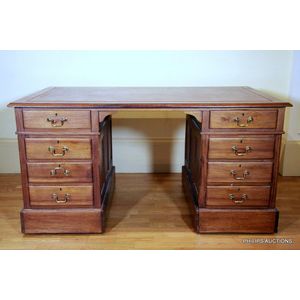1940s Walnut Partners Desk with Art Deco Base
You must be a subscriber, and be logged in to view price and dealer details.
Subscribe Now to view actual auction price for this item
When you subscribe, you have the option of setting the currency in which to display prices to $Au, $US, $NZ or Stg.
- Provenance - A term used to describe the provable history of an antique or work of art, and thus an additional aid to verifying its authenticity. Provenance can have an inflating effect on the price of an item, particularly if the provenance relates to the early settlement of Australia, a famous person, or royalty. Less significant are previous sales of the item through an auction house or dealer.
- Art Deco Period - The Art Deco period was a cultural movement that emerged in the 1920s and 1930s, and was characterized by its emphasis on modernism, luxury, and elegance. The name "Art Deco" comes from the Exposition Internationale des Arts Décoratifs et Industriels Modernes, a large exhibition held in Paris in 1925 that showcased the latest trends in decorative arts.
Art Deco was a reaction against the ornate and elaborate styles of the previous era, and reflected a new modern sensibility. It was characterized by streamlined, geometric shapes, bright colours, and the use of new materials such as chrome, glass, and Bakelite. Art Deco designers sought to create a sense of luxury and sophistication, often incorporating expensive materials such as ivory, marble, and rare woods.
Art Deco had a significant impact on a wide range of artistic fields, including architecture, fashion, graphic design, and interior design. Some of the most iconic examples of Art Deco architecture include the Empire State Building in New York City, the Hoover Building in London, and the Palais de Chaillot in Paris.
The Art Deco period came to an end in the 1940s, as World War II and changing cultural trends led to a shift in artistic styles. However, Art Deco remains an important influence on design and art, and continues to be celebrated for its modernist sensibility and glamorous aesthetic. - Bevel / Chamfer - In furniture making, a chamfered corner refers to a technique used to create a smooth, angled edge on the corner of a piece of furniture. This is typically done by cutting away a small portion of the corner at an angle, typically 45 degrees, creating a diagonal edge, rather than a sharp 90-degree angle. This technique can be used on various parts of a piece of furniture such as table legs, drawer fronts, or door frames. Chamfering can add visual interest to a piece and can help to soften the overall look of a piece of furniture. It is often used in conjunction with other techniques, such as rounding edges or using contrasting wood species to create a more elegant, sophisticated look. Chamfering is a simple way to add a touch of elegance to a piece of furniture and it is a common technique used by furniture makers.
- Plinth - The square or rectangular base of a piece of cabinet furniture, often ornamented with moulding. The plinth may be separate, as in some wardrobes or presses, and act as the support for the carcase. In a false plinth, the moulded boards may be attached directly to the piece. Furniture with a plinth base usually does not have separate feet. The term derives from architecture where it denotes the base of a column or statue.
- Pedestal Desk - A pedestal desk is a type of desk that consists of a large work surface supported by two pedestals or cabinets, one on either side. The pedestals are usually identical and contain drawers and cabinets for storage. The desk's design allows it to be placed in the centre of a room, as the back of the desk is usually finished with the same veneer as the front.
Pedestal desks were popular in the 18th and 19th centuries, and were usually made from high-quality wood, such as cedar, mahogany, walnut or oak, and were decorated with intricate carvings and other decorative details. They were used by businessmen, politicians, and other professionals, and were considered a symbol of status and success.
This item has been included into following indexes:
Visually similar items

A large mahogany twin pedestal partners desk, circa 1860, with a tooled green leather writing plane above two pedestals each with four drawers with brass escutcheons conforming to the recessed hinge style handles, and to the rear two keyed cupboards each w

An American mahogany twin pedestal desk, circa 1920, with a tooled green leather writing plane above two pedestals, one with a set of four drawers and the other with a drawer above a cupboard, all with various compartments and partitions, another cupboard

A George IV mahogany partners desk with a tooled leather top, above three frieze drawers on end pedestals. 77 cm high, 168 cm wide, 81 cm deep.

A hardwood partner's desk, mid 20th century, the desk with a brown leather gilt tooled surface, the pedestals each with four drawers with brass swing handles and raised on plinth bases, cupboards to the reverse. Height 78 cm, width 152 cm, depth 90 cm
